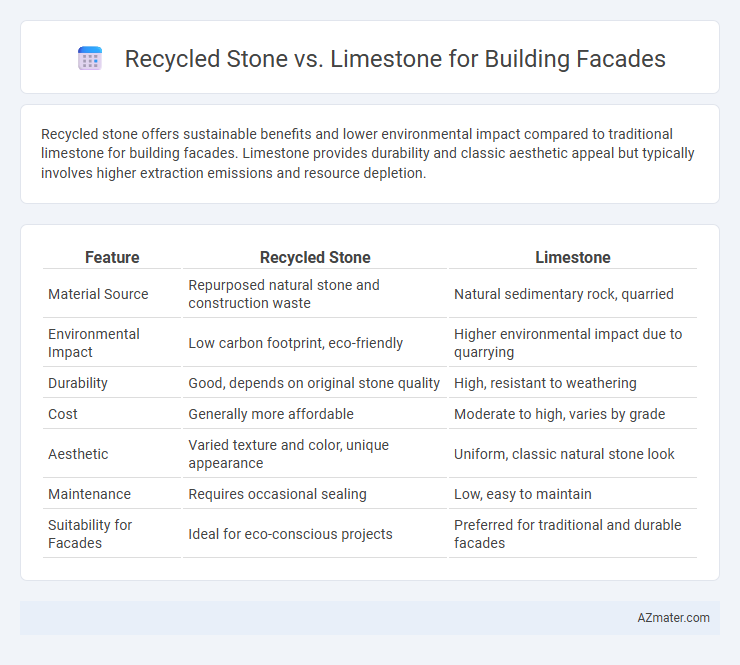Recycled stone offers sustainable benefits and lower environmental impact compared to traditional limestone for building facades. Limestone provides durability and classic aesthetic appeal but typically involves higher extraction emissions and resource depletion.
Table of Comparison
| Feature | Recycled Stone | Limestone |
|---|---|---|
| Material Source | Repurposed natural stone and construction waste | Natural sedimentary rock, quarried |
| Environmental Impact | Low carbon footprint, eco-friendly | Higher environmental impact due to quarrying |
| Durability | Good, depends on original stone quality | High, resistant to weathering |
| Cost | Generally more affordable | Moderate to high, varies by grade |
| Aesthetic | Varied texture and color, unique appearance | Uniform, classic natural stone look |
| Maintenance | Requires occasional sealing | Low, easy to maintain |
| Suitability for Facades | Ideal for eco-conscious projects | Preferred for traditional and durable facades |
Introduction to Building Facade Materials
Recycled stone offers an eco-friendly alternative to traditional limestone for building facades, utilizing reclaimed materials that reduce environmental impact and waste. Limestone remains a popular choice due to its natural durability, aesthetic appeal, and ease of carving for architectural details. Selecting between recycled stone and limestone depends on factors such as sustainability goals, budget constraints, and desired facade longevity.
What is Recycled Stone?
Recycled stone is a sustainable building material made from repurposed natural stone fragments or construction debris, offering an eco-friendly alternative to traditional limestone. Unlike limestone, which is quarried directly from natural deposits, recycled stone reduces environmental impact by diverting waste from landfills and conserving natural resources. Its use in building facades supports green construction practices while maintaining durability and aesthetic appeal comparable to that of limestone.
Overview of Limestone as a Facade Material
Limestone, a sedimentary rock predominantly composed of calcium carbonate, offers exceptional durability and weather resistance, making it a preferred choice for building facades. Its natural variation in color and texture provides architects with versatile aesthetic options while maintaining structural integrity over time. Limestone also demonstrates excellent thermal insulation properties and can be easily carved or shaped, enhancing its functionality in decorative architectural elements.
Environmental Impact: Recycled Stone vs Limestone
Recycled stone significantly reduces environmental impact by minimizing quarrying and lowering energy consumption compared to limestone extraction, which involves extensive mining and habitat disruption. The carbon footprint of recycled stone is substantially lower due to decreased transportation and processing requirements, making it a sustainable choice for building facades. Limestone production emits higher levels of CO2 and contributes to ecosystem degradation, highlighting recycled stone's advantage in eco-friendly construction.
Durability and Longevity Comparison
Recycled stone offers enhanced durability due to its compact composition and resistance to weathering compared to traditional limestone, which is softer and more prone to erosion. Limestone facades typically require regular maintenance to prevent surface degradation, whereas recycled stone maintains structural integrity over longer periods with minimal upkeep. The longevity of recycled stone makes it a more sustainable choice for building exteriors, delivering both aesthetic appeal and long-term resilience.
Aesthetic Appeal and Design Flexibility
Recycled stone offers a unique, weathered aesthetic that adds character and history to building facades, while limestone provides a smooth, consistent texture with a range of natural colors ideal for classic and modern designs. The irregular shapes and varied tones of recycled stone enable creative, eclectic patterns, whereas limestone's uniformity allows for precise cuts and intricate architectural details. Both materials enhance design flexibility, but recycled stone excels in creating rustic, organic looks, and limestone suits elegant, clean-lined facades.
Cost Analysis: Upfront and Long-Term
Recycled stone typically offers a lower upfront cost compared to natural limestone due to reduced quarrying and processing expenses, making it an attractive option for budget-conscious facade projects. Long-term maintenance costs of recycled stone can be higher if the material lacks the durability and weather resistance of high-quality limestone, potentially requiring more frequent repairs or replacements. Limestone tends to have a higher initial investment but benefits from proven longevity and lower maintenance expenses over the building's lifecycle, providing better overall cost efficiency in long-term facade applications.
Installation Processes and Considerations
Recycled stone facade installation requires thorough cleaning and sorting to ensure structural integrity, often involving adhesive bonding or mechanical fixing methods tailored to varied stone sizes and shapes. Limestone installation demands precise cutting and anchoring due to its uniform texture and susceptibility to weathering, with careful consideration of moisture barriers to prevent erosion. Both materials require skilled labor for alignment and securing, but recycled stone offers more flexibility in design adaptations, while limestone provides a classic, consistent aesthetic with predictable handling requirements.
Maintenance Requirements for Each Material
Recycled stone requires minimal maintenance due to its durable composition and resistance to weathering, often needing only periodic cleaning to prevent surface dirt buildup. Limestone, while aesthetically pleasing, demands more frequent upkeep, including sealing every few years to protect against moisture absorption and erosion from acid rain. Regular inspections and timely repairs are essential for limestone facades to maintain structural integrity and appearance over time.
Conclusion: Choosing the Right Facade Material
Recycled stone offers strong environmental benefits, reducing waste and conserving natural resources while maintaining durability suitable for building facades. Limestone provides timeless aesthetic appeal and excellent weather resistance with a proven track record in construction. Selecting the right facade material depends on balancing sustainability goals, budget constraints, and desired visual characteristics to meet specific project requirements.

Infographic: Recycled stone vs Limestone for Building facade
 azmater.com
azmater.com